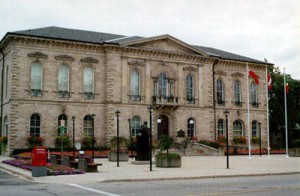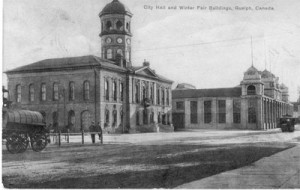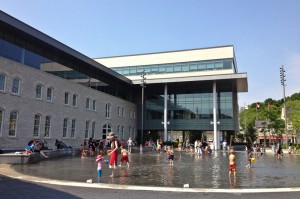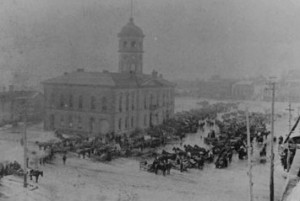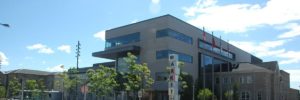On this page
Guelph City Hall
1 Carden Street, Guelph, Ontario N1H 3A1
Green Features
City Hall is built to meet the LEED Silver Standard (Leadership in Energy and Environmental Design) set out by the Canada Green Building Council. Its use of local and eco-friendly building materials, efficient lighting, its green roof and its heating and cooling systems are just some of the ways to reduce the City’s use of water and energy and lower its environmental footprint.
Compared to a typical office building, City Hall uses 30 to 40 per cent less water and energy.
Fewer cars commuting to City Hall
- Bicycle storage and showers encourage City employees to walk or cycle to work, which can reduce fuel consumption and greenhouse gas emissions from cars driving to and from City Hall.
- City employees can exchange a parking pass for a transit pass. Taking transit to City Hall reduces traffic congestion, air pollution and fossil fuel consumption as Guelph Transit vehicles use biodiesel fuel.
- Carpooling is promoted using an employee ride-sharing program.
- Using 43 underground parking spaces instead of a parking lot preserves green space and reduces storm water runoff. Limited parking also encourages City Hall employees to use other forms of transportation
Plant life inside and out
About half of City Hall’s roof is covered by a living, growing collection of plants. The green roof provides excellent insulation and helps to keep the building warm during the winter and cool during the summer. The soil and plants absorb rain water and melted snow to reduce stormwater runoff and, like all plants, they convert carbon dioxide into oxygen, which reduces air pollution.
Just inside the front doors of City Hall you can see a vertical garden called a living wall. The wall is filled with lush, green plants that act as air filters, improving the indoor air quality.
City Hall’s multi-floor design reduces its footprint and preserves green space while accommodating service counters, public meeting rooms, employee work spaces, Council Chambers and more.
A simple landscaped garden will be the green heart of City Hall. The courtyard will provide a pleasant setting for civic functions, and allows daylight to filter into work spaces near the centre of the building.
Less water, less waste
- City Hall’s efficient faucets and fixtures reduce the use of water in the building. Compared to a typical office building, City Hall uses 30 per cent less water each year.
- Landscaping outside the building features a variety of beautiful plants that are drought, disease and insect resistant, reducing the need for water or fertilizer.
- Drinking fountains encourage visitors and employees re-fill water bottles to reduce waste; bottled water will not be available in City Hall.
- The City strives to divert waste from landfill wherever possible, and City Hall is no different. Recycling bins will be provided at employee workstations, and green wet waste and clear waste bins will be provided in central areas. The employee lunchroom is equipped with refrigerators and microwaves where people are encouraged to bring a litter-less lunch
Less energy, lower emissions
Compared to a typical office building, City Hall uses almost 40 per cent less energy each year.
Natural and energy-efficient lighting
The design of City hall allows the sun to shine into work areas and minimizes the need for artificial light during the day. Energy-efficient lighting fixtures are used both inside and outside City Hall.
Motion sensors are used in common areas, and lights turn off automatically when they are not in use.
Minimal night-time light pollution – very little light is cast beyond the Civic Square.
Efficient heating and cooling
- City Hall uses a smaller than average heating and cooling system because of the building’s insulation, air-sealing, window glazing, and its green roof.
- For maximum energy-efficiency and comfort, City Hall has state-of-the-art control systems to manage temperature, humidity and fresh air exchange.
- High-efficiency natural gas boilers deliver warmth in the winter, and CFC-free chillers cool the building during the summer.
Eco-friendly building materials
- Typical carpets, glues and paints contain toxic volatile organic compounds (VOCs) that cause air pollution and potential health problems. Using low-VOC materials protects the health of the people building and working in City Hall.
- Flooring in the Mayor and CAO’s offices is made from bamboo rather than hardwood; bamboo grows much more quickly, and is more durable so it is more sustainable.
- At least 10% of the materials used to build City Hall came from local suppliers. Using local sources lowers the fuel needed to deliver supplies, and supports local businesses.
- Over half of the demolition and construction waste was diverted from landfill and recycled.
Building City Hall – by the numbers
Guelph has invested in a new City Hall to meet the needs of our growing city and consolidate operations that have, until now, been located in rented spaces throughout the downtown core. The new City Hall will mean better customer service, more meeting space for staff and the community, room to accommodate future growth, and efficiencies that come from staff working together in one location.
Guelph’s new City Hall will allow the City to realize hundreds of thousands of dollars of savings each year in rent, energy and water costs.
Rent savings each year
Eliminating rent costs on four downtown locations will save the City more than $685,000 per year.
Water and energy savings
City Hall is built to meet the LEED Silver Standard (Leadership in Energy Efficiency and Design) set out by the Canadian Green Building Council. The building’s green features mean that operating costs are 30 to 40 percent lower than that of a typical office building of the same size.
Thanks to its efficient faucets and fixtures, it uses more than 30 per cent less water than a typical office building. This amounts to a savings of more than 952,000 litres per year – enough to fill a bathtub every day for 17 years! Water efficiency will save the City nearly $2000 per year.
Because of its green roof, insulation, air sealing, insulation and high-efficiency heating, cooling and ventilation systems, City Hall will use almost 40 per cent less electricity and natural gas than a typical office building.

